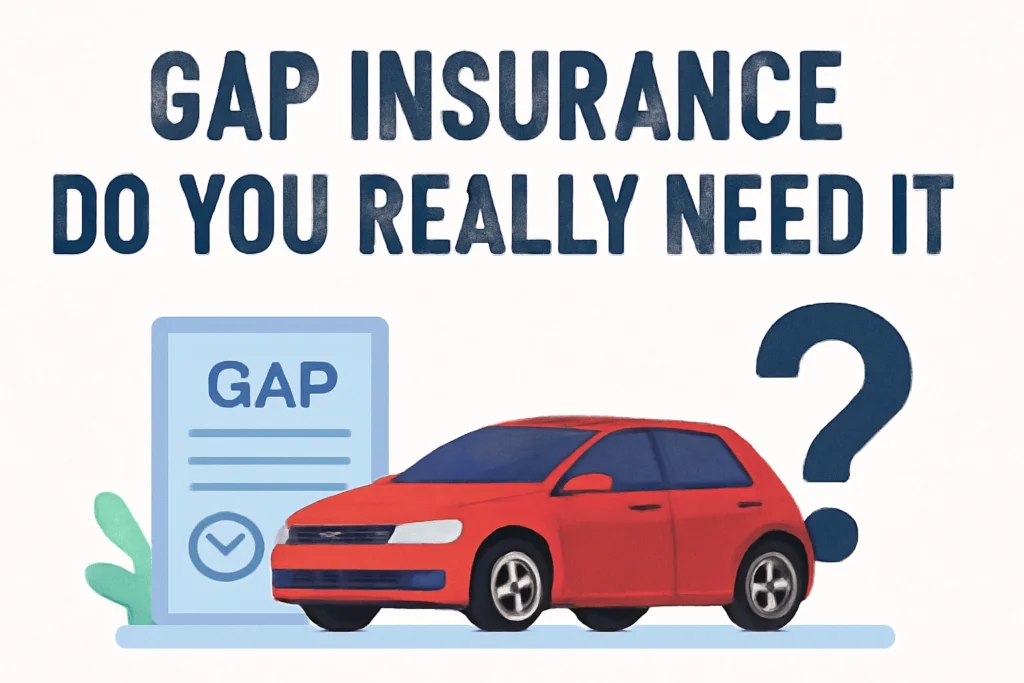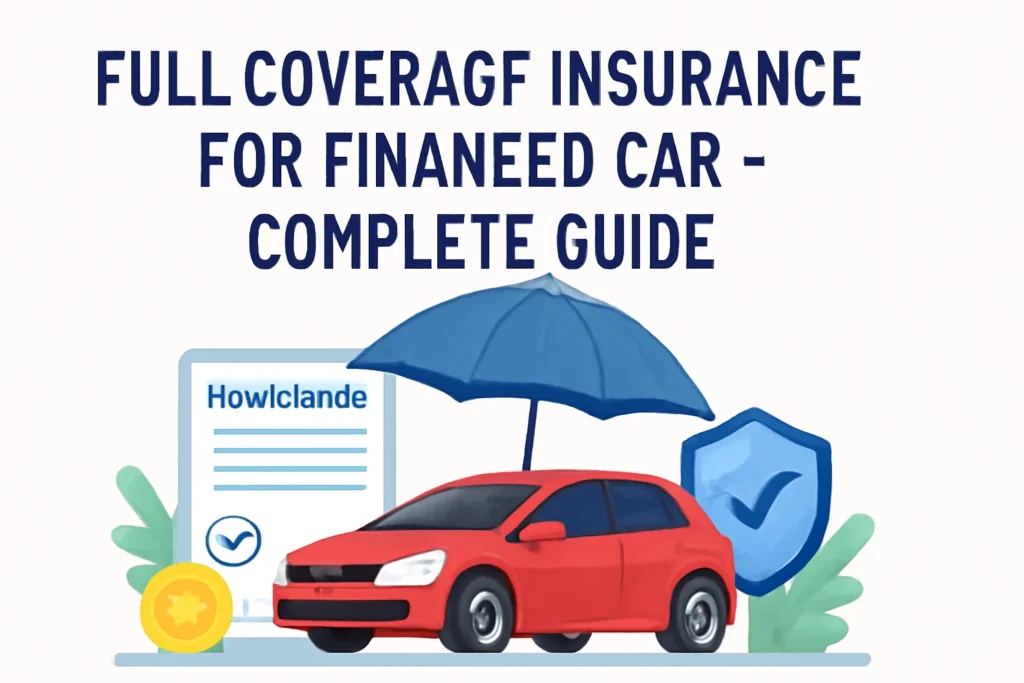Introduction
Financing a car means you’re sharing ownership with the lender until the loan is paid off, and they expect you to protect that investment. That’s where full insurance coverage comes in — a blend of liability, collision, and comprehensive coverage that safeguards both your vehicle and their financial stake. Unlike liability insurance, which only covers damage you cause to others, full coverage also protects your financed car from theft, accidents, or natural disasters. Lenders require it to ensure the car’s value is preserved, whether it’s a brand-new model or a used financed vehicle.
What is a Financed Car?
Definition of a Financed Car
A financed car is a vehicle you purchase through an auto loan, where the lender provides funds to buy the car, whether new or used. Until the loan is fully repaid, the lender holds a legal interest in the financed vehicle. This applies to both new and used financed cars, meaning you can finance a used car with similar loan terms.
How Auto Loans Work and Ownership Until Full Payment
When you finance a car, you agree to monthly payments that cover the loan balance, interest, and any lender-required costs, such as full coverage insurance. Ownership officially transfers to you only after the final payment, ensuring the lender’s investment remains secure during the finance period.
Understanding Full Coverage Insurance
Components of Full Coverage
Full coverage insurance on a financed car typically combines liability insurance, collision coverage, and comprehensive coverage, which is essential for new or used cars. Liability insurance covers damages or injuries you cause to others, collision coverage pays for repairs to your own financed vehicle after an accident, and comprehensive coverage protects against theft, fire, vandalism, or natural disasters. Lenders usually require all three types of insurance to protect their investment.
Full Coverage vs. Minimum State Requirements
Minimum state insurance requirements only ensure liability protection for other drivers, leaving your financed car at risk. Full coverage offers broader protection, covering damage to your own car and safeguarding the lender’s financial interest—whether you finance a new car or a used financed vehicle.
Why Lenders Require Full Coverage on a Financed Car
Protecting the Investment
When you finance a car, the lender has a financial stake in your vehicle until the loan is repaid. Full coverage insurance—including liability, collision, and comprehensive coverage—ensures the car is protected against damage, theft, or total loss. Whether it’s a new model or a used financed car, this coverage safeguards the lender’s investment and helps maintain the vehicle’s value during the finance period, ensuring you can apply for financing successfully.
Avoiding Force-Placed Insurance
If you fail to maintain full coverage car insurance, the lender may purchase insurance on your behalf—known as force-placed insurance. This option is often more expensive and may offer less protection than choosing your own full coverage policy. Maintaining the required liability coverage keeps your costs lower and avoids unexpected charges.
Full Coverage for a Used Financed Car
Do Used Cars Need Full Coverage?
Lenders typically require full coverage insurance, which includes liability coverage, for both new and used financed cars. Even though a used vehicle may have a lower market value, it’s still collateral for the auto loan, making it essential to purchase insurance on your behalf. Full coverage—including liability, collision, and comprehensive protection—ensures the lender’s investment is safe from accidents, theft, or natural disasters during the finance period.
Insurance Costs: New vs. Used
Full coverage on a used financed car can be less expensive than for a new vehicle due to its lower replacement value. However, factors like repair costs, the car’s age, location, and your driving history can raise your insurance premium. Lenders still mandate this coverage to protect against major financial loss, whether you finance a used car or buy it new, especially when you apply for financing and obtain a loan.
Insurance Requirements for Financed Cars
Common Coverage Types
Lenders usually set strict insurance requirements for financed vehicles to protect their investment. Full coverage typically includes liability insurance, collision coverage, and comprehensive coverage. Liability covers damage you cause to others, collision pays for repairs to your financed car after an accident, and comprehensive and collision coverage covers theft, fire, and natural disasters. GAP insurance is sometimes required, especially if the car’s value is less than the remaining loan balance.
Coverage Requirements Table
| Coverage Type | Required for Financed Cars? | Purpose |
|---|---|---|
| Liability Insurance | Yes | Covers others’ damages |
| Collision Coverage | Yes | Covers damage to your car |
| Comprehensive Coverage | Yes | Covers theft, fire, natural disasters |
| GAP Insurance | Sometimes | Covers loan balance if car is totaled |
GAP Insurance – Do You Really Need It?
What GAP Insurance Covers
GAP (Guaranteed Asset Protection) insurance is designed to cover the difference between your auto loan balance and your car’s actual cash value if it’s totaled or stolen. For financed cars—especially new or used financed vehicles—this coverage ensures you won’t be left paying a loan for a car you no longer have. Many lenders recommend or require GAP insurance to protect their financial interest when you apply for financing.

When It’s Worth Buying
GAP insurance is most valuable if your car’s depreciation outpaces your loan repayment. It’s worth considering when financing a new car, a high-interest auto loan, or a used financed car with a long repayment period. In these scenarios, GAP coverage can save you thousands by closing the gap between insurance payouts and your remaining loan balance.
Factors Affecting Full Coverage Insurance Costs
Car-Related Factors
The age, condition, and model of your financed car directly impact the insurance options available and their costs. Newer vehicles or high-value models often require higher premiums for full insurance coverage, while older used financed cars may be cheaper to insure due to lower replacement values.
Driver and Location Factors
Your driving history, credit score, and where you live all influence full coverage rates. Drivers with clean records in low-risk areas often pay less, while urban areas with higher accident or theft rates increase premiums for financed vehicles.
Lender Terms
Loan duration and lender-specific clauses can affect your required coverage. Longer finance periods or strict coverage requirements—such as GAP insurance—can raise overall costs, ensuring the lender’s investment remains fully protected throughout the loan term.
Pros and Cons of Full Coverage on a Financed Car
Advantages
Full coverage insurance offers financial safety for both you and the lender. It ensures your financed car is protected from accidents, theft, and natural disasters while meeting lender requirements for liability coverage. This compliance helps avoid costly penalties like force-placed insurance and provides peace of mind during the entire finance period.
Disadvantages
The main drawback is cost—full coverage premiums are higher than minimum liability insurance, which can strain budgets, especially on long-term car loans. For older or low-value used financed cars, the payout after a claim may be less than the total premiums paid, reducing its overall value. Still, lenders typically mandate it until the loan is fully repaid.
How to Save on Full Coverage Insurance
Comparison Shopping
Comparing quotes from multiple insurance companies is one of the most effective ways to lower the cost of full coverage for a financed car and manage your insurance premium. Rates can vary widely, so check options for both new and used financed vehicles.
Adjusting Deductibles
Raising your deductibles can reduce monthly premiums, but make sure you can afford the out-of-pocket cost if you need to file a claim. This balance can help you keep lender-required coverage without overspending.
Bundling Policies
Bundling your auto insurance with home or renters insurance often results in significant discounts. Many providers offer reduced rates for customers who combine policies, making full coverage on your financed vehicle more affordable while still meeting lender requirements.
Additional Resources for Smarter Insurance Decisions
In the insurance requirement section, it’s always wise to consult finance experts who understand both lending terms and insurance policies. Their insights can help you meet lender standards while avoiding unnecessary costs.
In the GAP insurance section, working closely with your Our finance team can help you navigate various insurance options for your financed car. ensures you choose coverage that makes sense for your loan balance, car value, and financial goals.
In the conclusion section, remember that TechyInfinity We offer in-depth guides and resources on car insurance, insurance coverage, and industry trends to help you make informed decisions.
FAQs
1. Is full coverage mandatory for all financed cars?
Yes, it is essential to consider your insurance options carefully. Most lenders require full coverage to protect both you and their investment in case of damage, theft, or total loss.
2. Can I drop full coverage after paying off my loan?
Yes. Once your loan is fully paid, you can switch to liability-only or another coverage type that meets your needs and budget.
3. How much does full coverage cost for a used financed car?
Costs vary based on your location, driving history, vehicle type, and coverage limits. On average, car insurance may range from a few hundred to over a thousand dollars per year.
4. Do lenders require GAP insurance for all financed cars?
Not always. GAP insurance is often recommended if you owe more than the car’s value, but some lenders make it a requirement in the loan terms for full coverage car insurance.
5. What happens if I don’t maintain full coverage on a financed car?
Your lender may add known as force-placed insurance to your loan, which is usually more expensive and offers limited protection compared to standard coverage.
6. Does full coverage cover mechanical breakdowns?
No. Full coverage typically includes collision and comprehensive insurance but not mechanical repairs. For that, you may need an extended warranty or mechanical breakdown insurance.
7. Is liability insurance enough for a financed car?
No. Liability insurance only covers damage you cause to others, not your own car, which is why you may need full coverage insurance. Lenders usually require collision and comprehensive coverage as well.
8. Can I choose my own insurance provider for a financed car?
Yes. You can shop around for the best rates and coverage options, as long as your policy meets your lender’s requirements.
Conclusion
Full coverage car insurance on a financed car isn’t just about meeting lender requirements — it’s about protecting your investment and giving yourself peace of mind. By understanding your options, comparing quotes, and regularly reviewing your policy, you can ensure you’re getting the best value for your money. For more insights and resources on smart financial decisions, visit TechyInfinity And explore expert tips tailored to your needs to help you navigate the process of applying for financing.


